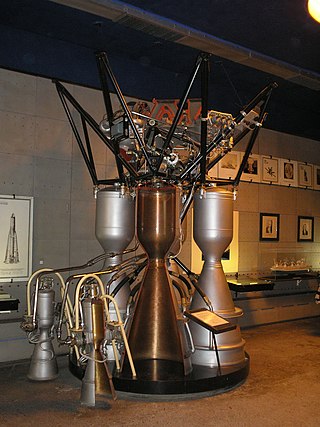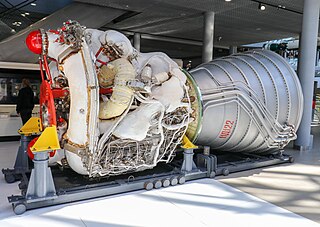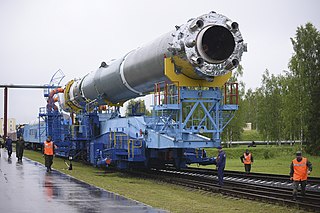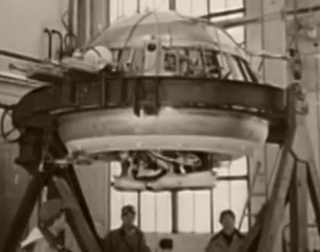Related Research Articles

The RD-170 is the world's most powerful and heaviest liquid-fuel rocket engine. It was designed and produced in the Soviet Union by NPO Energomash for use with the Energia launch vehicle. The engine burns kerosene fuel and LOX oxidizer in four combustion chambers, all supplied by one single-shaft, single-turbine turbopump rated at 170 MW (230,000 hp) in a staged combustion cycle.
The RD-8 is a Soviet / Ukrainian liquid propellant rocket engine burning LOX and RG-1 in an oxidizer rich staged combustion cycle. It has a four combustion chambers that provide thrust vector control by gimbaling each of the nozzles in a single axis ±33°. It was designed in Dnipropetrovsk by the Yuzhnoye Design Bureau as the vernier thruster of the Zenit second stage. As such, it has always been paired with the RD-120 engine for main propulsion.

The RD-58 is a rocket engine, developed in the 1960s by OKB-1, now RKK Energia. The project was managed by Mikhail Melnikov, and it was based on the previous S1.5400 which was the first staged combustion engine in the world. The engine was initially created to power the Block D stage of the Soviet Union's abortive N-1 rocket. Derivatives of this stage are now used as upper stages on some Proton and Zenit rockets. An alternative version of the RD-58 chamber, featuring a shorter nozzle, was used as the N-1's roll-control engine.

NPO Energomash "V. P. Glushko" is a major Russian rocket engine manufacturer. The company primarily develops and produces liquid propellant rocket engines. Energomash originates from the Soviet design bureau OKB-456, which was founded in 1946. NPO Energomash acquired its current name on May 15, 1991, in honor of its former chief designer Valentin Glushko.

The YF-100 is a Chinese liquid rocket engine burning LOX and kerosene in an oxidizer-rich staged combustion cycle.

The RD-107 and its sibling, the RD-108, are a type of rocket engine initially used to launch R-7 Semyorka missiles. RD-107 engines were later used on space launch vehicles based on the R-7. As of 2021, very similar RD-107A and RD-108A engines are used to launch the Soyuz-2.1a, and Soyuz-2.1b, which are in active service.

The Soviet RD-0120 (also designated 11D122) was the Energia core rocket engine, fueled by LH2/LOX, roughly equivalent to the Space Shuttle Main Engine (SSME). These were attached to the Energia core rather than the orbiter, so were not recoverable after a flight, but created a more modular design (the Energia core could be used for a variety of missions besides launching the shuttle). The RD-0120 and the SSME have both similarities and differences. The RD-0120 achieved a slightly higher specific impulse and combustion chamber pressure with reduced complexity and cost (but it was single-use), as compared to the SSME. It uses a fuel-rich staged combustion cycle and a single shaft to drive both the fuel and oxidizer turbopumps. Some of the Russian design features, such as the simpler and cheaper channel wall nozzles, were evaluated by Rocketdyne for possible upgrades to the SSME. It achieved combustion stability without the acoustic resonance chambers that the SSME required.

The RD-0124 is a rocket engine burning liquid oxygen and kerosene in an oxygen-rich staged combustion cycle, developed by the Chemical Automatics Design Bureau in Voronezh. RD-0124 engines are used on the Soyuz-2.1b and Soyuz-2-1v. A variant of the engine, the RD-0124A, is used on the Angara rocket family's URM-2 upper stage.
The RD-120 is a liquid upper stage rocket engine burning RG-1 and LOX in an oxidizer rich staged combustion cycle with an O/F ratio of 2.6. It is used in the second stage of the Zenit family of launch vehicles. It has a single, fixed combustion chamber and thus on the Zenit it is paired with the RD-8 vernier engine. The engine was developed from 1976 to 1985 by NPO Energomash with V.P. Radovsky leading the development. It is manufactured by, among others, Yuzhmash in Ukraine.
The RD-843 is a Ukrainian single nozzle liquid propellant rocket engine burning pressure-fed UDMH and nitrogen tetroxide. It is rated for up to 5 restarts, and can gimbal up to 10 degrees in each direction.

The RD-0110R is a rocket engine burning kerosene in liquid oxygen in a gas generator combustion cycle. It has four nozzles that can gimbal up to 45 degrees in a single axis and is used as the vernier thruster on the Soyuz-2-1v first stage. It also has heat exchangers that heat oxygen and helium to pressurize the LOX and RG-1 tanks of the Soyuz-2.1v first stage, respectively. The oxygen is supplied from the same LOX tank in liquid form, while the helium is supplied from separate high pressure bottles.

The RD-0210 (GRAU Index: 8D411K) is also known as the RD-465. It and its twin, the RD-0211, are rocket engines burning N2O4 and UDMH in an oxidizer rich staged combustion cycle. They have single nozzle, possess TVC and are the latest evolution in the RD-0203/4 lineage. They are the engines used on the Proton second stage. The RD-0213 is a fixed nozzle variation that is used on the RD-0212 module of the Proton third stage.

The RD-119 was a liquid rocket engine, burning liquid oxygen and UDMH in the gas-generator cycle. It has a huge expansion ratio on the nozzle and uses a unique propellant combination to achieve an extremely high isp of 352 s for a semi-cryogenic gas-generator engine. It also has a unique steering mechanism. The engine main nozzle is fixed, and the output of the gas generator is fed into four nozzles on the side of the engine. Instead of using gimbaled verniers to supply vector control, the combustion gases are distributed by an electrically driven system that can control the thrust among the nozzles.
The RD-810 (РД-810) is a Ukrainian liquid propellant rocket engine burning LOX and Kerosene (RG-1) in a staged combustion cycle. It has a single combustion chamber that provides thrust vector control by gimbaling of the nozzle in two axis by +/- 8°. It is being designed in Ukraine by Yuzhnoye Design Bureau for the prospective first stage propulsion of the Mayak rocket family.
The RD-861 is a Soviet liquid propellant rocket engine burning UDMH and nitrogen tetroxide in a gas generator combustion cycle. It has a main combustion chamber, with four vernier nozzles fed by the gas generator output. It can be reignited a single time.
The RD-855 (GRAU Index 8D68M]), also known as the RD-68M, is a liquid-fueled rocket engine with four nozzles. As a vernier engine, it provides fine steering adjustments for rockets. It is powered by a combination of N2O4, an oxidizer, and UDMH, a propellant. This combination is hypergolic, meaning the two substances ignite on contact, eliminating the need for an external ignition source.
The RD-856 (GRAU Index 8D69M), also known as the RD-69M, is a four-nozzle liquid-fuel rocket vernier engine, burning N2O4 and UDMH in a gas generator cycle. It was used on the R-36, Tsyklon-2 and Tsyklon-3 second stage as thrust vector control by gimbaling of its nozzle. The engine is distributed through a cylindrical structure that is integrated around the main engine RD-252 module. The structure includes aerodynamic protection for the nozzles. The engine was started by a pyrotechnic ignitor.
The RD-864 is a Soviet liquid propellant rocket engine burning UDMH and nitrogen tetroxide in a gas generator combustion cycle. It has a four combustion chambers that provide thrust vector control by gimbaling each nozzle in a single axis ±55°. It is used on the third stage of the R-36M UTTKh and Dnepr. For the R-36M2, an improved version, the RD-869 was developed.

The Cyclone-4M is a Ukrainian carrier rocket which is being developed for commercial satellite launches.

Blok E is the propulsion unit of Soviet lunar module LK, developed in the 1960s by Yuzhnoye Design Bureau as a part of the human lunar landing program.
References
- ↑ Brügge, Norbert (2016-07-11). "Ukrainian space-rocket and missile liquid-propellant engines". B14643.de. Retrieved 2015-08-06.
- 1 2 3 4 5 6 Degtyarev, A. V.; Shulga, V. A.; Zhivotov, A. I.; Dibrivny, A. V. (2013). "СОЗДАНИЕ СЕМЕЙСТВА КИСЛОРОДНО-КЕРОСИНОВЫХ ЖИДКОСТНЫХ РАКЕТНЫХ ДВИГАТЕЛЕЙ НА БАЗЕ ОТРАБОТАННЫХ ТЕХНОЛОГИЙ ДЛЯ ПЕРСПЕКТИВНЫХ РАКЕТ-НОСИТЕЛЕЙ ГП "КБ "ЮЖНОЕ"" [THE DEVELOPMENT OF LOX - KEROSENE LIQUID ROCKET ENGINES FAMILY FOR PERSPECTIVE LAUNCH VEHICLES OF YUZHNOYE SDO BASED ON PROVEN TECHNOLOGIES](PDF). АВИАЦИОННО - КОСМИЧЕСКАЯ ТЕХНИКА И ТЕХНОЛОГИЯ (in Russian). 2013 nr. 01 (98). National Aerospace university them. NE Zhukovsky: 44–50. ISSN 1727-7337 . Retrieved 2016-07-11.
- ↑ "RD-801". Defense Industry Of Ukraine Products And Services. Archived from the original on 2016-08-18. Retrieved 2016-07-11.
- 1 2 3 "RD-801". Yuzhnoye. Archived from the original on 2016-07-09. Retrieved 2016-07-11.
